Boise State’s recent Fiesta Bowl appearance, despite a loss to Penn State, masked a simmering concern voiced by offensive coordinator Dick Koetter: the Broncos’ struggle to compete in the era of Name, Image, and Likeness (NIL) deals. Koetter, in a candid Facebook post, highlighted the stark financial disparity between Boise State and its competitors, revealing that the Broncos’ top players are receiving offers up to ten times higher from other institutions. This financial disadvantage, he argues, puts Boise State at a significant recruiting and retention disadvantage, jeopardizing its ability to maintain a competitive roster. While acknowledging that factors beyond monetary compensation influence player decisions, Koetter stressed the undeniable impact of NIL deals in the current college football landscape.
Koetter’s plea for fan contributions to Boise State’s NIL fund underscores the program’s struggle to match the financial firepower of wealthier programs. He emphasized the need for additional resources to retain existing talent and attract future stars of the caliber of Ashton Jeanty and Ahmed Hassanein. His call to action echoed the sentiments of head coach Spencer Danielson, who acknowledged the importance of every dollar in the Broncos’ efforts to remain competitive. This public appeal highlights the increasing pressure on universities and their athletic programs to secure private funding to navigate the rapidly evolving NIL landscape.
The financial challenges faced by Boise State are symptomatic of a broader trend impacting college athletics. The introduction of NIL deals has created a free-market environment where player compensation is increasingly driven by market forces. This shift has amplified the preexisting financial disparities between institutions, creating a more stratified competitive landscape. Schools with greater resources or access to affluent donor bases are often able to outbid smaller programs for top talent, creating a cycle of success that further widens the gap between the haves and have-nots.
Koetter’s concerns also shed light on the complex dynamics at play in player recruitment and retention. While the opportunity to earn substantial income through NIL deals has become a significant factor for athletes, other considerations, such as coaching staff, team culture, and academic opportunities, still hold sway. Boise State, while facing financial constraints, may still attract players who prioritize these non-monetary factors. However, the escalating financial incentives offered by other institutions present a formidable challenge for programs like Boise State seeking to maintain a competitive edge.
The situation at Boise State exemplifies the broader debate surrounding NIL and its impact on college athletics. Proponents argue that NIL empowers student-athletes to capitalize on their marketability and receive fair compensation for their contributions. Critics, however, express concerns about the potential for NIL to create an uneven playing field, exacerbate existing inequalities, and prioritize financial gains over the educational mission of collegiate sports. The ongoing discussion centers on finding a sustainable model that balances the interests of athletes, institutions, and the overall integrity of college sports.
As Koetter heads into his final coaching season, his concerns about Boise State’s future in the NIL era serve as a stark reminder of the challenges facing college athletic programs. The Broncos’ struggle to compete financially underscores the need for a comprehensive and equitable approach to NIL, one that ensures fair competition and preserves the integrity of college sports while allowing student-athletes to benefit from their name, image, and likeness. The future of college football may hinge on finding a sustainable solution that addresses the financial disparities highlighted by Koetter and others, ensuring that smaller programs like Boise State can continue to thrive in the ever-evolving landscape of college athletics.

